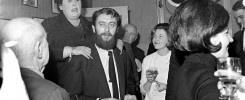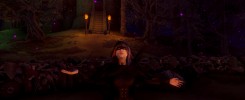BACKGROUND
Below I am addressing the first set of questions pertaining to this Master’s project. I missed these when posted on the University site, so I have a little catching up to do. 😊
What is your main focus/concept/direction?
To bring spoken word stories from Irish myth and Legends into VR. Realising new dimensions to these stories and creating a new level of emotional engagement and empathy with the content.
What motivates and inspires you to carry out this research?
An interest in Irish mythology and folklore, combined with the desire to present these stories in a new medium. These stories are truly epic, beautiful, and magical. The descriptions are so vivid and at the same time so incredible that bringing them to life in VR is something I have thought about for a long time, particularly after discussions with Ian Hannigan. Ian has far more knowledge of these myths and legends than I do, and is an oracle of knowledge on Cú Chulainn and Táin Bó Cúailnge.
In a time when podcasts and audio books are revitalising indigenous spoken word stories, and enabling storytellers all over the world, from all societies and cultures, to reach a global audience, it makes sense to me to see how one can realise stories in an immersive visual medium that can enhance the story and it’s emotional impact.
Stories of myth and legend can be a positive tool for understanding and reconciliation. Hearing and seeing another perspective. This was demonstrated by “”The Enemy” (2017), a VR Experience by Karim Ben Khelifa, bringing people face to face with their perceived enemy and hearing their stories.
Similarly, “Easter Rising: Voice of a Rebel” VR (2017), enables you to “Step into one man’s memories and journey back to a moment that changed Irish History forever: the 1916 Easter Rising”
Whilst the stories I am dealing with are of a non-fictional nature, stories of folklore and mythology have a great power in terms of ethnopolitical identity. In “Regional and Ethnic Conflicts: Perspectives from the Front Lines”, Reuter, T. & Carter, Judy, (2009), within the section, “The role of constructive, transcultural storytelling in ethnopolitical conflict transformation in Northern Ireland” (2015) Jessica Senehi noted that “Ethnopolitical conflicts involve the collision of two stories, two cultural narratives.” And went on to highlight the positive aspects of storytelling in terms of reconciliation and “de-silencing experience”.
Ethnopolitical conflicts involve the collision of two stories, two cultural narratives.
Whilst the stories I am dealing with are of a non-fictional nature, stories of folklore and mythology have a great power in terms of ethnopolitical identity. In her book, “The role of constructive, transcultural storytelling in ethnopolitical conflict transformation in Northern Ireland” (2015) Jessica Senehi noted that “Ethnopolitical conflicts involve the collision of two stories, two cultural narratives.” And went on to highlight the positive aspects of storytelling in terms of reconciliation and “de-silencing experience”.
These stories may be of a personal nature but can also be part of a common culture or heritage. Even within Irish Mythology there are multiple versions of the same stories told from differing perspectives in different communities. Even where one community’s hero is another’s villain, the messages of these stories of myth and folklore remain largely positive. And I believe VR is an ideal medium to passively observe another perspective without conflict, listen to other voices, and experience their world.
My own personal experience is significant in this regard. My mother being Irish, my father being English, we moved to Ireland when I Was 12. Up to that time, I had been taught history from a very English colonial perspective. It was the narrative of heroes and champions, with extraordinarily little mention of the darker aspects of the empire.
My mother had told my sister and I stories from Irish myth and legends when we were younger, but my knowledge of Irish history was lacking and never taught in England. This includes any mention of England’s 600-year subjugation of Ireland and the Irish, as well as the great famine of the mid 1800s that claimed 1 million lives in Ireland. Which was far less to do with plant disease and far more to do with England’s hegemony of the time.
We moved to Donegal in the 80s during the troubles. The most Northern border county of the republic. Suffice as to say, my wakeup call was not at easy one in terms of discovering a different narrative.
Had schools in England taught history from a more empathetic perspective and had stories from both history and mythology of the two cultures been shared, I believe relations could have been vastly improved between both North and South as well as Ireland and the UK.
I feel that the later history of oppression in Ireland naturally overshadows the more ancient history of Ireland as well as the rich stories of myth and legend. This too detracts from a positive sense of self-identity. Meaning that is something I would like to address in a small part as well as bringing these stories to a broader global audience.
Going beyond Irish myth and legends, not all stories reach the mainstream, but podcasts and audio books are just some mediums by which individual and indigenous stories from all corners of the world are reaching a greater audience. Not all these stores will be made into films, but VR offers an exciting opportunity and inexpensive way to create a deeper engagement with these stories.
What are your ambitions - what do you want the project to do? Why?
To create engagement with these spoken world stories and bring new dimensions to the characters, and world’s in which these stories reside.
The stories from Irish mythology represent some of the oldest spoken word stories in the world. Told form many different perspective and heavily entangled epics, they are part of a rich culture and history, yet they are relatively hidden from the world in comparison to, for example, Norse mythology. Many legends from several cultures in Europe have borrowed aspects from these stories and adopted them into their own (later) myths and legends. I think it’s time to see if they can find a place in the virtual realm, a world not constrained by physics and where all the fantastical elements of these stories can be realized. So, I would like to address this, and also reengage others who may have heard these stories when they were younger.


